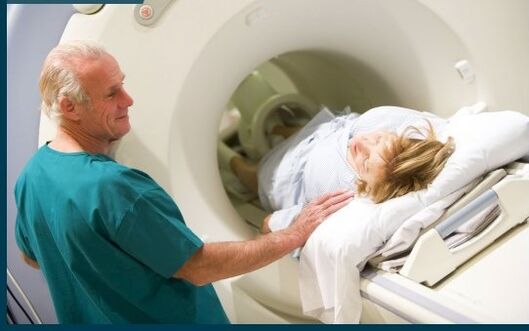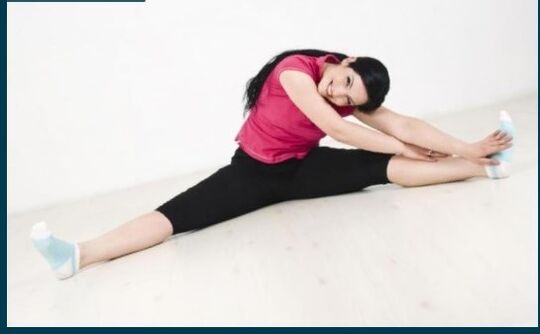Osteochondrosis of the spine is a degenerative-dystrophic pathology, which is characterized by damage to the articular surfaces, intervertebral discs and the muscle-league-like apparatus.The disease has a chronic course and is full of serious consequences.
The therapeutic effect of osteochondrosis is complex.The timely diagnosis of the disease is important - the earlier the therapy begins, the higher the likelihood of a positive result.It is almost impossible to turn back the degenerative processes, but you can stop them in the debut phase.Progressive osteochondrosis can lead to projections, hernia of intervertebral discs, neurological pathologies.
General information about the disease
Osteochondrosis is the most common spine and one of the most frequently diagnosed human pathologies of all existing ones.The disease can be seen as a special billing of our type for the uprising and the advantages of civilization.Osteochondrosis does not have in animals because their spine is located horizontally.
If you have regular or regular back pain in 75-80% of cases, these are manifestations of osteochondrosis.
Degenerative changes develop less frequently in the Brustr region than in the sacral and neck of the back.Usually osteochondrosis of the Brustr region appears after 40 years.The predisposing factors are both excessive loads on the spine and a sitting lifestyle.In the latter case, the blood circulation and nutrition of cartilage and bone structures are disturbed, which leads to their gradual dystrophy.
In recent decades, doctors have found the widespread "rejuvenation" of the disease.Osteochondrosis is also diagnosed in people between the ages of 25 and 30, which is associated with a change in environmental status on the planet as well as the type of nutrition and the way of life of modern humans.The presence of your own car, office work, the preference of passive relaxation on the computer is active-disher factors do not contribute to the health of the musculoskeletal system.
The risk of breast (and any other) osteochondrosis is that it is almost impossible to restore the tissue of the intervertebral discs: This means that the segments affected by dystrophic and degenerative transformations are sentenced to slow but unstoppable destruction.The task of treating osteochondrosis is to stop the destruction of hard and soft tissues and to minimize the risk of complications.
Features of the thoracic osteochondrosis
The osteochondrosis of the breast zone has a negative impact on the human ability to exercise.The progression of the disease is also affected with priests of the nerve endings of the spinal cord, which inevitably influences the functional status of internal organs.In advanced clinical situations of breast osteochondrosis, heart function and breathing problems cause.
The Brustr region is characterized by low mobility;The load on it is not as large as on the neck and on the lower back.Anatomically thoracic vertebrae are connected to the ribs and the sternum and together represent a sedentary and strong design that is protected from damage and external influences.For this reason, the chest osteochondrosis rarely manifests itself in the early stages.The same fact determines the relative rarity of the diagnosis of "breast osteochondrosis".
The provocative factors of the disease are usually injuries, violations of attitude, scoliosis and other anatomical disorders.Signs of an osteochondrosis of the chest region manifest themselves quite late, usually in the stage of the compression of nerve roots.
How to manifest the chest osteochondrosis
The first manifestation of the disease is the pain between the shoulder blades.In the case of loads or vice versa, manifest in a position in the morning after a long stay.The pain often runs on the intercostal nerve and occurs when sneezing, coughing and faster.

Pain in the heart is possible and resemble an attack by the angina pectorator and the manifestation of heart failure.The similarity of symptoms with heart disease often leads to incorrect diagnosis.Sometimes symptoms resemble signs of inflammation of the bladder, ulcers or gastritis.In order to identify the true cause of pain manifestations, it is necessary to subject a complete clinical diagnosis.
Other signs of thoracic osteochondrosis, in addition to pain:
- Neurological symptoms - a feeling of "goosebumps" on the skin in the chest and stomach;
- Daubiness of skin areas, impaired sensitivity;
- Violations of the heart, pelvic organs (with the development of the compression of the spinal cord);
- Intercostal neuralgia - pain in the area of ribs with a transition to the sternum (develops in the form of seizures and is usually provoked by lifting weights, hypothermia, stress);
- Dorsalgia - stiffness of the muscles of the case and pain during inhaling/exhaling;
- Reflex muscle tension (the body tries to reduce pain symptoms due to the physiological immobilization of the affected spine).
The longer the disease lasts, the more its signs pressed out.It is important not to try to eliminate pain with analgesics and other medication, but to determine their cause with clinical methods.Self -denominator for osteochondrosis at best is senseless and, in the worst case, dangerous and full of complications.
The causes of pathology
The doctors did not complete the mechanisms that start the process of fabric regeneration.It is believed that osteochondrosis causes an inappropriate distribution of the loads on the vertebrae with a weak muscle corset of the back.Circumstances that increase the likelihood of the disease have been clarified in detail.
The main factors of influence:
- Hypodynamics (sitting work, a tendency to passive calm);
- Excessive loads due to the birth of activity;
- Spinal damage;
- Obesity;
- Inheritance;
- Irrational nutrition;
- Craumatic of the spine;
- Violation of attitude, non -compliance with working hygiene;
- Metabolic pathologies;
- Age -related dystrophic processes in tissues;
- Constant vibration exposure (for example when working with a hammer book);
- Flat feet;
- Go in high shoes;
- Stress;
- Infectious diseases.
The risk of the disease pather, maker, truck driver, building owners and office workers.Most of the time, the disease has a multifactorial nature - a combination of several internal and external factors leads to its development.
The widespread opinion that osteochondrosis develops due to "salt deposits" is wrong from a scientific point of view.The calcification of hard drives and cartilage is really with degenerative diseases of the spine, but this is not the main cause, but a consequence of the pathology.
Diagnostic methods
The identification of the disease begins with the initial examination of the patient, the examination of information about the symptoms, the lifestyle of the patient, the type of diet and the associated diseases.The scanning of the affected areas is carried out.

The following diagnostic procedures are prescribed:
- General trial of blood and urine;
- Radiography;
- Ultrasound, MRI and CT;
- Myelography - The introduction of contrast to the spinal cord to examine its structure.
The most indicative diagnostic method is x -beam.Typically, targeted radiography of specific spinal segments is carried out.Images enable the atrophy of discs (reducing their thickness), the presence of osteophytes - bone growth, changes in the form of the spine.
In order to rule out other pathologies with similar symptoms, consultations from cardiologists, gastroenterologists and other specialists (and relevant studies - ECG, gastroscopy) may be required.The main treatment is carried out by an orthopedic surgeon or a vertebrologist - a spine specialist.
Modern methods of therapy for thoraxosteochondrosis
The therapeutic effect begins with the recognition of the basic cause of the disease.If this is an infection, antibiotics treatment is carried out when the weakness of the muscle apparatus is carried out to strengthen them.Treatment is more common, with the exception of situations with a difficult clinic.
The main goal of the treatment is to minimize degenerative processes and their consequences.Each specific case requires the production of an individual treatment scheme, including medicinal products, physiotherapeutic methods and methods for further rehabilitation.They mainly practice conservative therapy, the operations that are less frequently prescribed.
Experienced doctors are never undergoing treatment due to an isolated methodology or purely medication.The treatment of diseases of the spine with pills that eliminate pain symptoms is practice without a therapeutic perspective and a sign of unprofessional approach.However, it is impossible to completely do without medication - especially at the acute stage of the disease.
Drug treatment
Use the following groups of medicines:
- Analgetics;
- Anti -inflammatory medication;
- Steroids;
- Musorelaxants to relieve cramps;
- Vitamins.
Preparations are mainly used in the early stage of the treatment.They stop acute pain, eliminate inflammation (if available), stimulate metabolic processes.Medications are more common (in the form of ointments), less often - used inside in the form of tablets.It is even less often necessary to make an injection in the affected area - this method is referred to as "Novocaine blockade".
Physiotherapy
Physiotherapeutic methods receive the leading role in degenerative pathologies of the sternum back.These methods remove pain, inflammation and restore the diet of affected tissue.Hardware and other exposure methods are used:
- Laser treatment;
- Magnetotherapy;
- Amplipulsterrapie;
- Ultrasound pollution;
- Balneotherapy (treatment with water);
- Paraffin therapy;
- Dirt;
- Settlement - cold therapy;
- Electrophoresis and phonophoresis.
The advantage of physiotherapy in its absolute security.For health reasons, this method has no contraindications.The competent use of physical techniques also offers a healing effect in the most difficult cases.
Independent physiotherapeutic method - reflex therapy: effect on the acupuncture points of the body.The most famous type of reflex zone massage is acupuncture.Cauterization is also carried out, acupressure.It has been proven that a competent effect on certain zones self -healing mechanisms eliminates pain.
Therapeutic gymnastics
Training therapy is a method that is used to treat osteochondrosis and to prevent complications.The complex of physical exercises is selected individually.The purpose of the training therapy is to reduce the pressure on the nerve roots, strengthen the ligaments and muscles and prevent projections and hernia.

Gymnastics complexes should be carried out either under the guidance of a qualified instructor or in strict agreement with the safety rules.It is dangerous to overload the muscles, so the exercises must be accompanied by rest times.
Manual therapy
The massage against osteochondrosis has the same goals as physiotherapy and exercise therapy reduz pain, improves the functionality of the band and muscle apparatus and stimulates the blood circulation.Professional competent massage confiscates the diet of soft tissues and cartilage and accelerates the regeneration processes.The use of mechanical devices - applicators, electrical and roller massages are permitted.
A separate type of manual therapy is osteopathy.The method includes a specialist for diagnostic and therapeutic manipulation of the hands.Such a massage is characterized by softness and physiology.Osteopathy eliminates tissue damage and has no age restrictions.
diet
The main principles of nutritional therapy for osteochondrosis: balance, the presence of all necessary trace elements, vitamins, a reduced number of calories.Another important criterion is the presence in the menu of the products that are responsible for the synthesis of cartilage tissue in the body.These connections are referred to as Mucopolysaccharides: The largest number of such substances is contained in idiots, jellies and flood courts.
Radical therapy
In modern clinics, an operation with breast osteochondrosis is extremely rare.Operations may only be necessary if complications occur in the form of a persistent radicular syndrome.Intervention can be assigned to the development of projections and hernia.
prevention
It is much easier to prevent the disease than to carry out long -term, sometimes long -term therapy.The prevention of osteochondrosis should be carried out from childhood.Degenerative processes are disabled by: proper attitude, dosage of loads on the spine, compliance with security during sports, rational nutrition, sleep on the maximum flat surface.The timely recognition of the first signs of the disease and the strict implementation of the doctor's recommendations is important.





















